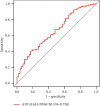Diagnostic Value of Prostate-Specific Antigen Combined with Plasma miRNA-149 Expression in Patients with Prostate Cancer Based on Experimental Data and Bioinformatics
- PMID: 35935308
- PMCID: PMC9337946
- DOI: 10.1155/2022/6094409
Diagnostic Value of Prostate-Specific Antigen Combined with Plasma miRNA-149 Expression in Patients with Prostate Cancer Based on Experimental Data and Bioinformatics
Abstract
Purpose: The aim of this study is to explore the diagnostic value of prostate-specific antigen (PSA) combined with serum miRNA-149 expression in prostate cancer (PCa) by conducting experiments and bioinformatics analysis. Patients and Methods. 50 PCa patients were enrolled on the experimental group from January 2020 to December 2021. 56 patients with benign prostatic hyperplasia (BPH) were selected as the control group at the same time. Real-time fluorescent quantitative PCR was applied to investigate the miRNA-149 expression. PSA was detected by using a chemiluminescence meter using Abbott i4000. Applying bioinformatics analysis, we explored the expression of hsa-miR-149 in PCa in The Cancer Genome Atlas (TCGA) database. Kaplan-Meier analyses were used to evaluate the prognostic value, and the ROC curve was applied.
Results: The expression level of miRNA-149 in the PCa group was significantly higher than that in the BPH group (P < 0.05). The PSA level in the PCa group was also significantly higher than that in the BPH group (P < 0.05). TCGA data analysis revealed that PCa tissues had significantly increased hsa-miR-149 expression. The results of survival analysis showed that patients with high expression of hsa-miR-149 had better prognosis. Additionally, the pathological N stage of PCa correlates with the hsa-miR-149 expression level (P = 0.002). According to ROC curve analysis, the region under the curve was 0.653, 95% CI: 0.576-0.730.
Conclusion: High expression of serum miRNA-149 is associated with PCa patients. Although combined PSA did not improve the diagnostic efficacy, miRNA-149 has high specificity in the diagnosis of PCa. miRNA-149 might be a novel marker for early diagnosis and prognosis assessment for PCa.
Copyright © 2022 Hao Wang et al.
Conflict of interest statement
The authors declare that they have no conflicts of interest.
Figures






Similar articles
-
Urinary hsv2-miR-H9 to hsa-miR-3659 ratio is an effective marker for discriminating prostate cancer from benign prostate hyperplasia in patients within the prostate-specific antigen grey zone.Investig Clin Urol. 2022 Mar;63(2):238-244. doi: 10.4111/icu.20210493. Investig Clin Urol. 2022. PMID: 35244999 Free PMC article.
-
Diagnostic and prognostic value of serum miR-15a and miR-16-1 expression among egyptian patients with prostate cancer.IUBMB Life. 2018 May;70(5):437-444. doi: 10.1002/iub.1733. Epub 2018 Mar 9. IUBMB Life. 2018. PMID: 29522280
-
miRNA-21 as High Potential Prostate Cancer Biomarker in Prostate Cancer Patients in Indonesia.Asian Pac J Cancer Prev. 2023 Mar 1;24(3):1095-1099. doi: 10.31557/APJCP.2023.24.3.1095. Asian Pac J Cancer Prev. 2023. PMID: 36974566 Free PMC article.
-
Assessment of miR-98-5p, miR-152-3p, miR-326 and miR-4289 Expression as Biomarker for Prostate Cancer Diagnosis.Int J Mol Sci. 2019 Mar 6;20(5):1154. doi: 10.3390/ijms20051154. Int J Mol Sci. 2019. PMID: 30845775 Free PMC article. Review.
-
A MicroRNA Approach to Evaluating Elevated Prostate Cancer Risk in Cancer-Free Men.Crit Rev Eukaryot Gene Expr. 2024;34(6):61-69. doi: 10.1615/CritRevEukaryotGeneExpr.2024053672. Crit Rev Eukaryot Gene Expr. 2024. PMID: 38912963 Review.
Cited by
-
Current advances of liquid biopsies in prostate cancer: Molecular biomarkers.Mol Ther Oncolytics. 2023 Jul 19;30:27-38. doi: 10.1016/j.omto.2023.07.004. eCollection 2023 Sep 21. Mol Ther Oncolytics. 2023. PMID: 37575217 Free PMC article. Review.
References
MeSH terms
Substances
LinkOut - more resources
Full Text Sources
Medical
Research Materials
Miscellaneous
